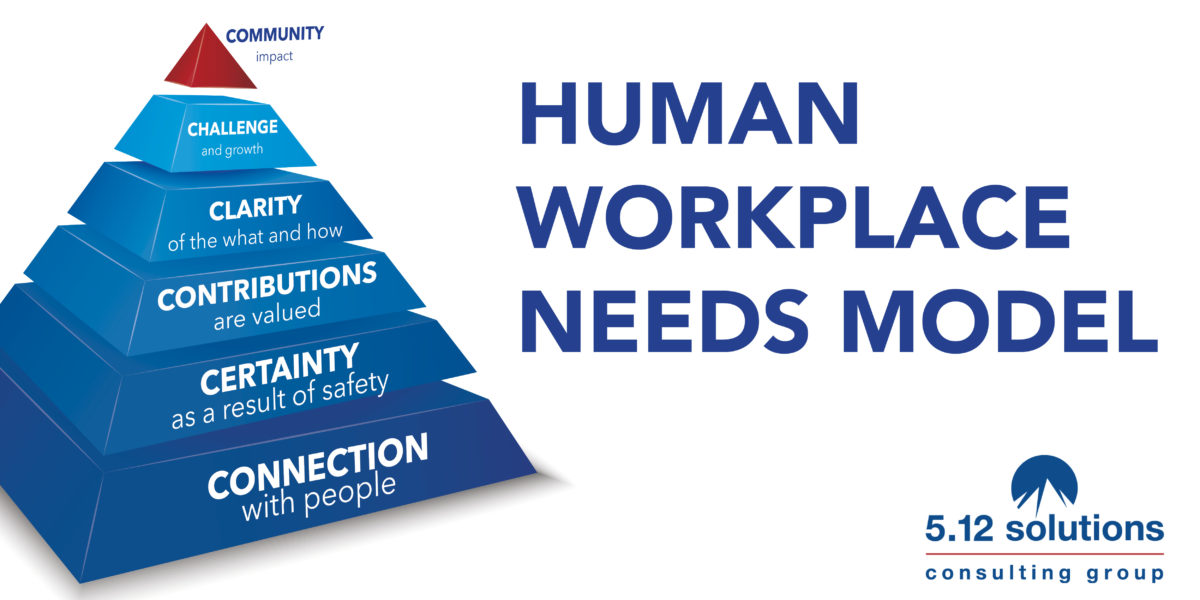We are continuing our Personal Foundations journey in this post by exploring our human workplace needs – the necessary ingredients essential to being fulfilled in the workplace. If you missed our previous posts in this series on leadership vision, values and identity, check those out as well as the accompanying Personal Foundations toolkit.
If COVID-19 has taught us anything, it is how deeply human our experience is in the workplace. To me, that’s good news. My firm belief is that the more that we can tap into our humanity, the more successful we can be both personally and professionally.
In fact, we’ve noticed in our work, coaching and training thousands of leaders worldwide, that the common thread between all people in the workplace lies in six human needs. When individuals, teams and employers can create an environment where most of our human needs are met, people will demonstrate remarkable levels of commitment.
Our Human Workplace Needs model is a pathway to tap into our deep humanity. It’s a framework to do three things:
- Number 1 – Understand what’s important to you individually.
- Number 2 – It’s a framework to create a healthy and aligned team environment.
- Number 3 – It’s a model to help nurture a more human organizational culture.
The 6 Cs of Human Workplace Needs
Connection with People
Connection is the first core need and so central to our humanity.
Everyone has this need. As with all other needs, we seek to fulfill it in either healthy or unhealthy ways.
Connection is about the need to feel loved and to belong. That may sound soft in most corporate workplaces, but it’s not.
In the context of a team, when people feel loved and feel like they belong, they trust others, will take more risks in conversations, and move faster with less drama and politics.
Certainty as a Result of Safety
This is the second Human Workplace Need and includes both physical and psychological safety.
In many organizations, like those in manufacturing or mining, physical safety has long been a priority. In today’s pandemic and post-pandemic environment, there is a need in all organizations to keep people physically safe.
Certainty is also about psychological safety. Organizational behavioral scientist Amy Edmondson of Harvard first introduced the concept of “team psychological safety” and defined it as “a shared belief held by members of a team that the team is safe for interpersonal risk taking.”
When people find certainty due to both physical and psychological safety on a team, they will take more risk – expressing different opinions, making decisions in the face of conflicting information and asking for cross-functional help when complexity increases.
Contributions are Valued
At the end of the day, people want to know that they have a voice and that they will be heard. People want to feel and believe that they matter. Without this need being met, people rarely feel a sense of commitment to a leader, team or organization.
When team members value each other’s contributions, they listen to understand, draw each other into conversations and focus on alignment, not agreement – meaning, they ensure voices are heard and move forward even if they disagree with each other.
Clarity of the What and How
Clarity of the what refers to understanding performance expectations.
Clarity of the how refers to understanding behavioral expectations.
Teams that have clarity:
- Understand their singular purpose and how their purpose differs from any other team in the organization.
- They know their objectives and key results.
- They align on key decisions and actions at the end of meetings.
- They have norms that guide their interactions.
Challenge and Growth
As human beings, we are either growing or dying.
Unfortunately, many corporate environments suck the soul out of us.
It doesn’t have to be that way.
When we create a work environment that fosters growth, we tap into this core human workplace need which leads to true fulfillment.
Teams that thrive in this area create opportunities to learn from each other instead of being protective of their functional areas of the business. They expect a lot, and they tolerate very little. Team members challenge each other and provide each other with regular feedback and feedforward.
Community Impact
Imagine what would happen if people could connect their work to making a bigger impact in this world.
What if you could do well, and also do good for humanity, and for our community?
Business can be a means to making a positive contribution to our communities.
Even if your business doesn’t embrace that concept, you can use your platform as a leader and individual to make a difference in others’ lives.
On teams that meet this need for community impact, team members put team and organizational results above their own individual and functional needs. They lose sleep over concerns about their customer’s businesses, rather than their own, and they consider their impact on their local and global community.
Identify Your Human Workplace Needs
The more we can tap into our human workplace needs, the better equipped we’ll be to create a healthy, aligned and more human workplace.
To support you along the way, download the Personal Foundations Toolkit below to identify your key needs and those of the stakeholders around you.

